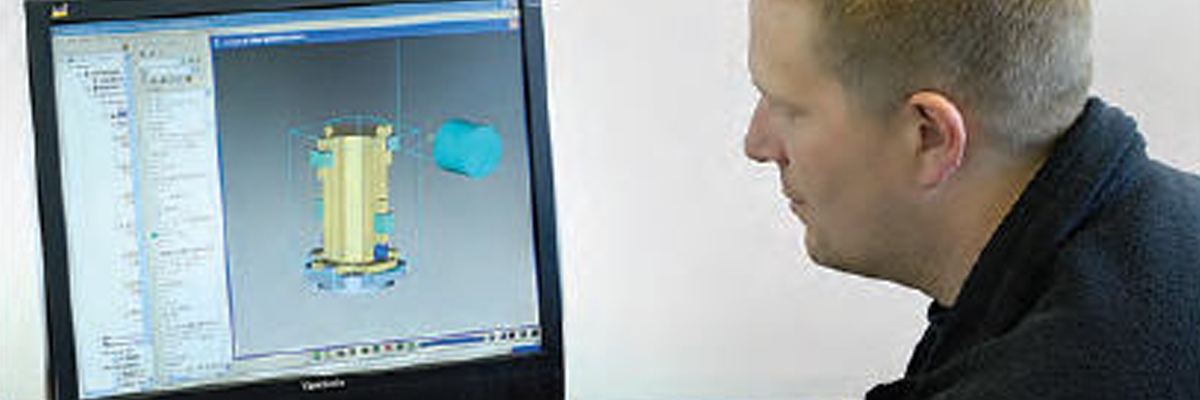Verify and trust
HydraForce Inc. manufactures hydraulic cartridge valves, electrohydraulic controls and integrated-circuit manifolds. Its standard and custom manifolds for mobile equipment applications permit users to consolidate hydraulic systems, minimize external connections and reduce installation and maintenance time.
At the company’s 72,000-sq.-ft. machining facility in Lincolnshire, Ill., more than 700 different manifold blocks from about 1½”×2½”×3″ to 5″×5″×17″ are machined on seven Kitamura horizontal machining centers served by multiplepallet workhandling systems.
Cara Sexton, plant manager, said the facility’s continuous-improvement efforts focus on maximizing the quality, reliability and flexibility of machining operations. The constantly changing variety of manifold configurations puts a premium on minimizing setup times and avoiding machine crashes as new programs are introduced.
In prior years, Sexton said, shop personnel “spent an enormous amount of time at the machine, driving the machine to get through the program for the setup of the part.” She added that it was possible a programming error could cause a crash that would take a machine out of action for days or weeks, and perhaps require repairing or replacing a $30,000 spindle.
To address those production issues, the facility began to implement VERICUT NC-program verification software from CGTech, Irvine, Calif., in early 2007 for the manifold machining process. The software simulates and verifies NC toolpaths to eliminate programming errors and reduce cycle time.
HydraForce loaded the program with information regarding all aspects of the machining process, including tooling and fixturing. Sexton pointed out that the seven Kitamura VMCs are identical, down to their 150-tool magazines. “We can run any program, in any machine, at any time and not have to worry about having tools in incorrect pockets,” she said.
Now, manifold designs from the HydraForce engineering group are programmed in Mastercam, and VERICUT software simulates and verifies the NC program. The simulated part is compared to a Pro/Engineer model of the part using the simulation software’s Auto-Diff feature, which matches the simulated model to the design model to assure the toolpath accurately represents the original design concept. That feature also enables programmers to check for gouges or excess material generated by the NC program and to correct those program errors prior to machining.
“The software allows us to do a real simulation of the machine in the office at the computer, instead of at the machine,” Sexton said. “It runs the G code and will tell if there is a potential crash. It has actually caught errors in some of our Pro/E design files from engineering. That alone has saved the company thousands of dollars.”
In addition, setup time was reduced. Jay Brizzolara, who handles scheduling for manifold machines, said, “Our setup times went from a couple of days to about 3 hours.” As a result, the facility has reduced the minimum cost-efficient lot size from 54 pieces to 20 to 25 pieces. Brizzolara added that the software “makes us feel comfortable not sitting through the setup run the whole time; we have the confidence it is not going to crash the machine because of a typo in the program, a depth that is too deep for the drill or any other unforeseen event.”
Sexton noted that since the facility implemented the simulation software, there have been no machine crashes due to programming errors.
Overall, a key objective is maintaining scheduling flexibility. Sexton said, “If one of our customers gets into a jam, we always have the flexibility to get something on the machine. If we have material in the house, we can program, set up, produce the block, inspect it, send it out for anodizing and get it back in a day and half.”
She said the flexibility “helps us execute our company mission, namely, to create worldwide customer delight by providing the highest-quality products and the most responsive customer service in the world, at a globally competitive cost.”
The ultimate goal, Sexton said, is “to minimize the amount of time our setup people are at the machine doing the actual setup, and then be able to program the part, hit the button, walk away from the machine and never have to worry about crashing the machine or producing a scrap part.”
Overall, a key objective is maintaining scheduling flexibility. Sexton said, “If one of our customers gets into a jam, we always have the flexibility to get something on the machine. If we have material in the house, we can program, set up, produce the block, inspect it, send it out for anodizing and get it back in a day and half.”
She said the flexibility “helps us execute our company mission, namely, to create worldwide customer delight by providing the highest-quality products and the most responsive customer service in the world, at a globally competitive cost.”
The ultimate goal, Sexton said, is “to minimize the amount of time our setup people are at the machine doing the actual setup, and then be able to program the part, hit the button, walk away from the machine and never have to worry about crashing the machine or producing a scrap part.”
 Germany
Germany Italy
Italy USA
USA South Korea
South Korea UK
UK India
India France
France China
China Japan
Japan
